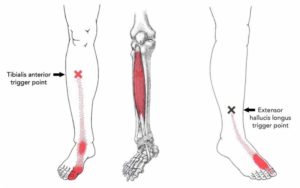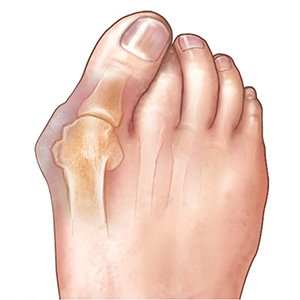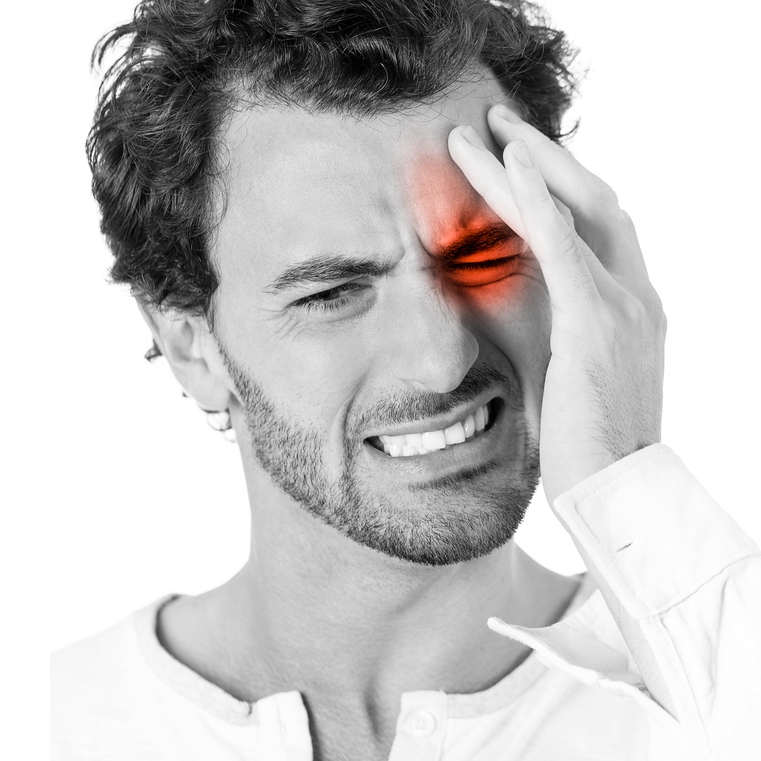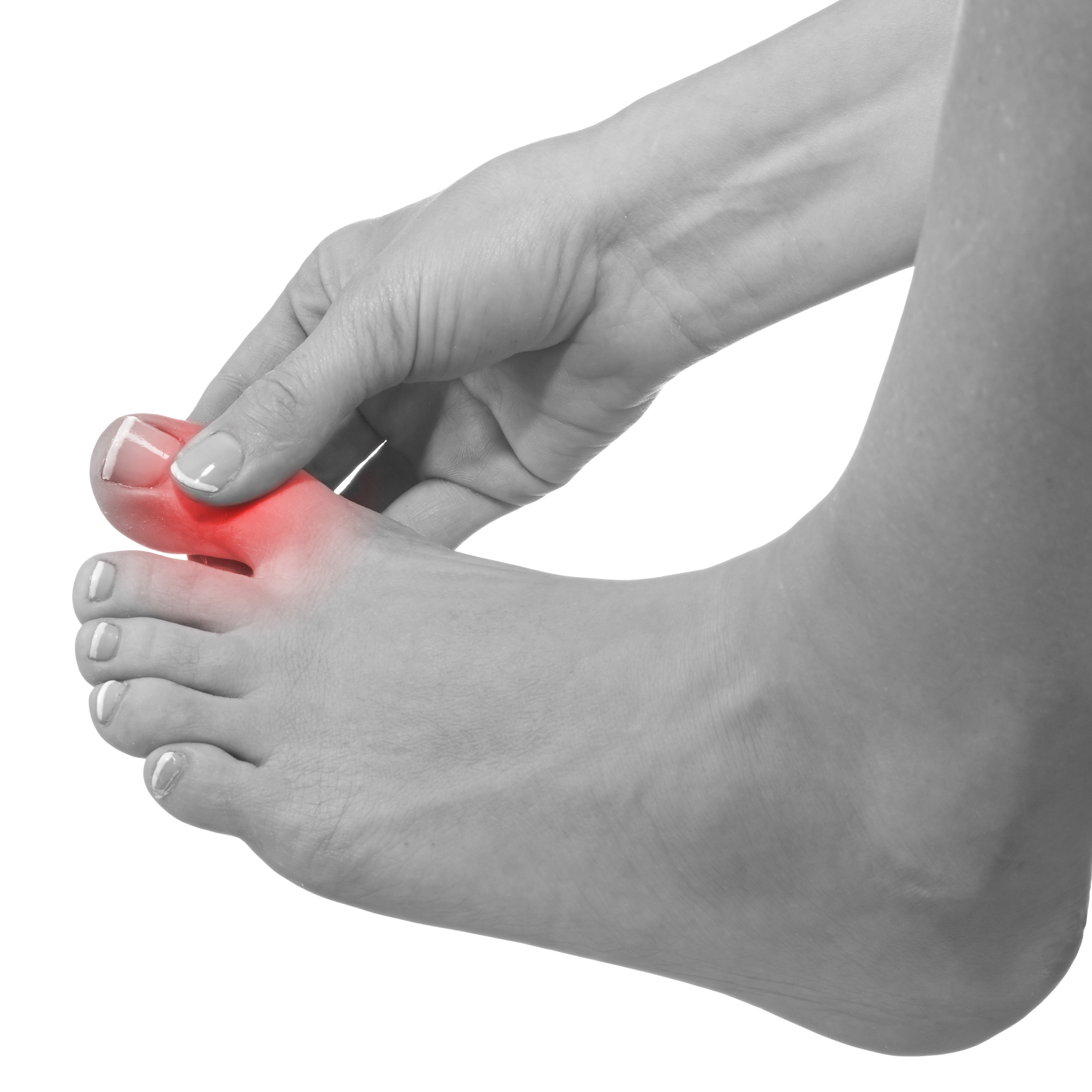The Foot Drop Muscle…
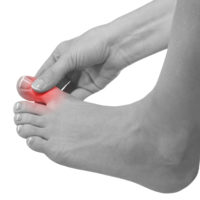
Chronic big toe and ankle pain can be caused by trigger points in the Tibialis Anterior (TibA) muscle. Pain from this muscle can also extend across the top of your foot, behind the big toe.
It can even seem to radiate up towards trigger point on the front of the calf.
This is a common problem for many runners and other athletes. You may have also discovered that your TibA is inhibited and not engaging well with other muscles in your calf. How does this happen?
The TibA is typically either injured in an accident or by acute overload or over-training. It doesn’t usually originate as a chronic condition through repetitive strain or microtrauma.
The most likely way for you to activate TibA trigger points is a fall or twisted ankle, similar to what might sprain or fracture your ankle. In addition, catching a toe, tripping or stumbling can also activate TibA trigger points.
In addition, like its partner, TibP, this muscle is vulnerable from walking or running on surfaces that are inclined, slant to the side or uneven.
Further, TibA trigger points can also be activating by downhill skiing in those not conditioned for it. Finally, because of similar stretching of TibA, driving with a sharply angled accelerator can activate trigger points.
TibA helps with dorsiflexion. This means that the continuous engagement of tight muscles on the back of the calf (soleus and gastroc), which are plantar flexors, will stress your TibA and can activate trigger points in it.
Note that trigger points in related muscles like the big toe extensor can cause similar big toe and ankle pain. However, a skilled therapist can distinguish between these.
More information on the anatomy and functions of the TibA is in the Extras sections at the end of this article.
Myofascial Treatment of Tibialis Anterior
Self Compressions
A roller like the Tiger Tail is fantastic for this. Begin by gently rolling the entire lower leg, aiming to increase circulation and warm the muscles up. Gradually increase pressure.
Then begin to work a little deeper, searching for tender areas. Move more closely to the TibA trigger point about 2/3 of the way up the front of the calf.
When you feel you have found it, stop rolling and experiment with gently rocking and and wiggling of the roller on this area, while continuing to maintain pressure, until any pain subsides and the muscle releases.
Because the soleus and the gastroc oppose the dorsiflexion of TibA, this should be done for the trigger points in the soleus and gastroc as well.
Stretches
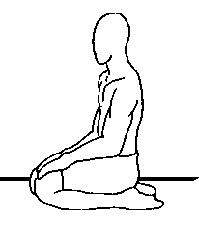 The TibA is quite easy to stretch. The simplest stretch is the to simply sit on your heels. Because TibA acts as a dorsiflexor, this is a good, but still partial, prepatory stretch. If you cannot comfortably sit on your heels, try using one or two yoga blogs to support your butt. This will take some of the stress off of your knees and ankles.
The TibA is quite easy to stretch. The simplest stretch is the to simply sit on your heels. Because TibA acts as a dorsiflexor, this is a good, but still partial, prepatory stretch. If you cannot comfortably sit on your heels, try using one or two yoga blogs to support your butt. This will take some of the stress off of your knees and ankles.
Next we may want to try to stretch the TibA through eversion with plantar flexion. Ideally, we want to turn the ankle out to the side (eversion) to counter the tendency of TibA to pull it to inversion. So, attempt to find a seated pose that allows you to move the ankle side to side through its entire range of motion while pointing the foot.
Other Techniques
Because the muscle is so superficial it responds easily to kinesio taping and hot and cold therapy. We also use techniques like “post-isometric relaxation” to help reset the TibA.
Strengthening
 In addition, for runners and other athletes, it may be helpful to increase the strength and aerobic capacity of both TibA/TibP and the “Fibs” that assist them in stabilizing the ankle. For example, we like the stretches and strengthening exercises in this series of videos. It’s not exactly the way we would do it, but she’s pretty good! The QR Code will take you directly to it if you’re reading from a pdf or print out.
In addition, for runners and other athletes, it may be helpful to increase the strength and aerobic capacity of both TibA/TibP and the “Fibs” that assist them in stabilizing the ankle. For example, we like the stretches and strengthening exercises in this series of videos. It’s not exactly the way we would do it, but she’s pretty good! The QR Code will take you directly to it if you’re reading from a pdf or print out.
Finally, we return to some possible adjustments in activities that perpetuate the problem.
It is best to avoid walking on inclined, slanted or uneven surfaces. However, if necssary, the muscles of the calf should be gently stretched, both before and after the activity, if possible. Also, we recommend some simple lifestyle changes, such as using the cruise control when driving significant distances.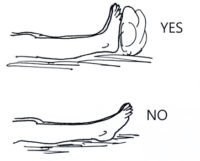
In general, your leg muscles will feel better if you keep them in a neutral position at night. Try to avoid tight or heavy bed coverings.
A pillow or bolster placed at the foot of the bed may help to gently keep the feet in a neutral position. We do not recommend devices that pull, push or fix the feet into a particular position during sleep.
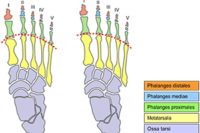 If you have trigger points in the calves we will usually want to check you for Morton's Foot Structure (MFS). This common skeletal variation makes your foot want to pronate. So it makes sense that a muscle whose primary function is to resist pronation would be unhappy.
A simple correction with a posture control insert is usually all that is needed. Less often, the bones in the foot move too much and the arch has fallen. This requires an appropriate arch support that can be added to the posture control insole.
Next, we will probably perform a preliminary screening for differences in leg length. Because of the role of the fibs as lower muscular outrigger, a difference in the length of your legs makes these muscles work harder. Finally, we will also probably screen you to see if the two sides of your pelvis are different sizes.
Unsurprisingly, if you have a combination of these structural variations, they will compound each other. Fortunately, we can easily correct all three conditions. This makes other treatments much more effective.
If you have trigger points in the calves we will usually want to check you for Morton's Foot Structure (MFS). This common skeletal variation makes your foot want to pronate. So it makes sense that a muscle whose primary function is to resist pronation would be unhappy.
A simple correction with a posture control insert is usually all that is needed. Less often, the bones in the foot move too much and the arch has fallen. This requires an appropriate arch support that can be added to the posture control insole.
Next, we will probably perform a preliminary screening for differences in leg length. Because of the role of the fibs as lower muscular outrigger, a difference in the length of your legs makes these muscles work harder. Finally, we will also probably screen you to see if the two sides of your pelvis are different sizes.
Unsurprisingly, if you have a combination of these structural variations, they will compound each other. Fortunately, we can easily correct all three conditions. This makes other treatments much more effective.
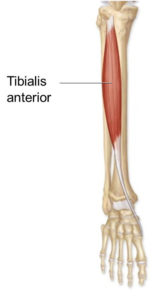
Let’s take a very quick look at the anatomy to understand how this muscle works. Tibialis anterior is located in the front of the calf, just below the skin. It attaches to the tibia and the tissue in between the leg bones and some of the other muscles. It runs down toward the foot. Then, its tendon crosses in front of the ankle and runs under the arch, attaching to the bones of the foot. So, it pulls up on the arch and helps invert your foot.
This muscle works together with it’s partner deep in the back of the leg (tibialis posterior, TibP) and the fibularis muscles (Fibs) coming from the outside of the heel to form a sort of stirrup under the rear of the arch.
If you compare this diagram to the one our Tibialis Posterior (TibP) post you can see how the muscles attach differently. Your TibA comes from the front and TibP from the back
TibA helps TibP to prevent excessive pronation of the foot during the midstance of walking or running. TibA can do this because of its attachment under your arch. However, its primary job is to prevent “foot slap” following heel strike. It does this by shortening and pulling your foot up towards your head. Therefore, it helps your foot clear the floor during the swing phase of your gait. Finally, TibA helps you maintain standing balance with lengthening contractions that control backward sway. TibA can do this because it acts as a tension element across the front of the foot, ankle and calf.
TibA As a Stabilizer
TibA is really a stabilizer. In fact, we seldom consciously engage our TibA to invert or dorsiflex our foot. This makes it easy for us to forget about it. However, when we develop “amnesia” in a particular muscle, it is likely to become inactive. Then, overloading this muscle will cause trauma that becomes taut bands. Finally these become trigger points that inhibit the proper function of the muscle, weakening it further.
“Tibialis anterior is vigorously active during jogging, running, jumping and other sports activities, including throwing, tennis and golf swings and hitting a baseball”
When we think about the activity of TibA when engaging the upper body, it is clear that it is a really important stabilizing muscle. Additionally, the same thing is also happening when TibA stabilizes the foot during walking and running or controlling backward bends.
Professional Treatment With Us
Take some time. Treat yourself. You deserve it.
Book a treatment this month and receive 20% off a three session package.
Janet was great. FANTASTIC person who knew how to treat and deal with my conditions. Very informative. Finally, someone who knew what I was talking about.
Really Good
It was interesting, and helpful for my IT band and hip
My experience was wonderful. Janet was very kind and attentive. I felt great after my session and would recommend to try it out.
The lady that assisted me was awesome! I suffer from fibromyalgia and when I left I felt like a brand new person! I plan to return when I get time!
Janet was great - knowledgeable and she found all my "hot spots."
Seriously, if you are looking for massage therapy that actually does your body good--that changes its function for the better and actually makes pain go away--then this is the place you need to come. Not Massage Envy. Not a chiropractor. You need trigger point from knowledgeable experts in the craft.
If your have pain in any part of your body this is the place to go. It focus on the muscles where the pain is. you will feel like a new person. Awesome will be returning. Thanks nice friendly and attentive
amazing!!!
I felt so much better after my appointment. Thank you and thanks for the self care tips!
Experienced therapist. Feel great after appointment...
Highly recommended!
What a great experience. The provider was able to recommend things I can do to improve my pain. Address issues I didn't even share with her that she was able to tell just by her exam and treating me for what i went for. Will be back. Feeling grateful
I spent so much money on chiropractors. This is much better. Everybody should try it out.
Beautiful, relaxing setting. Therapist was knowledgable and professional. I'll be going back. Thank you.
Janet is very informative. I loved that she explained which muscles/groups she was working on. I learned a lot about my posture and why some of my muscles are not activating. She also provided me with a list of considerations and excercises to improve my posture. I will be back!
Janet has a unique gift and talent in trigger point therapy. I’m definitely seeing her again!
I loved my experience. Janet is extremely knowledgeable in a vary wide variety of conditions. She is thorough and attentive. Makes you feel right at home!
It's like an hour of physical therapy (the good parts of P.T. where they massage you and stretch you). She also takes time to explain some ways to help your specific issues. Highly recommend!
Janet is very knowledgeable and informative. She thoroughly explains where you have weakness and what muscles are over compensating. She gives exercises, stretches, or everyday changes you can make to help you are progress on your own. I highly recommend a visit!
Janet was very knowledgeable and never in a hurry. She took her time explaining every little detail, great service
Felt much better after the trigger point massage, highly recommend.
Excellent
What About My Pain?
Clearly, everyone is different. Many of us have additional challenges and complications. Naturally, we tailor our treatment plans to the individual. However, there are common foundations in this work with everyone.
Fortunately, if you are having similar issues, you may find that a just few treatment sessions helps! We will identify and treat root causes of your individual case.
Clearly, everyone is different. Many of us have additional challenges and complications. Naturally, we tailor our treatment plans to the individual. However, there are common foundations in this work with everyone.
We are licensed professionals. In addition, we all have additional training and certifications in advanced techniques. For instance, this includes trigger point therapy, fascial stretching, neuromuscular and movement therapy. Also we offer kinesio taping, myofascial release, cupping, acoustic compression, self-care classes and more. In fact, we often combine several of these techniques into a single session..
Of course, no one wants chronic pain! Fortunately, can work together with you to help sort out the issues.
Click here or all us at 630-858-0000 today to make an appointment!
More info at: WestSubPainRelief.com
You can also take a picture of this QR code with another phone and share or view the entire article:
If reading from a pdf or printout, you will find links and videos at: https://WestSubPainRelief.com/big-toe-ankle-pain-tibialis-anterior-muscle

